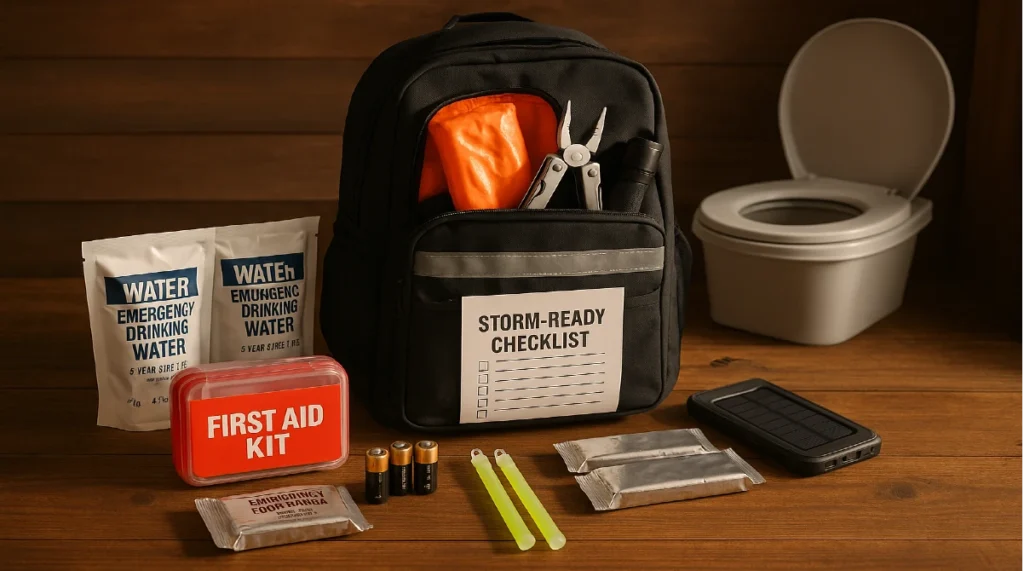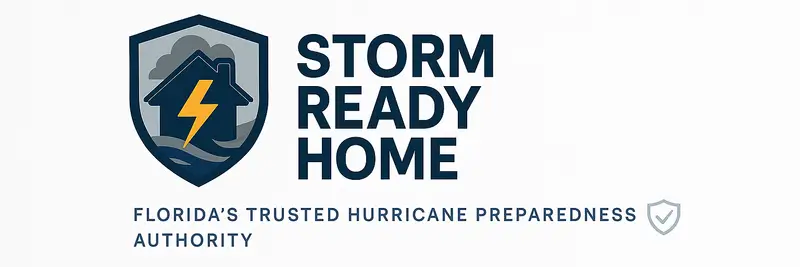Emergency Preparedness Kits: Your Go Bag and First Aid Essentials

Ready-Made Emergency Kits for Storms, Blackouts, and Go Bags
When severe weather strikes or the power suddenly goes out, there often isn’t time to gather essentials. That’s why having emergency preparedness kits—also called ready-made kits or go bags—can mean the difference between calm and chaos.
This guide outlines what to expect in a professionally pre-assembled emergency preparedness kit, how to choose the right one for your household, and where to store it for easy access during a crisis.
Why Ready-Made Kits Make Sense
In emergencies, simplicity and speed are critical. A quality emergency preparedness kit removes guesswork, ensuring you have essentials like food, water, lighting, first aid, and backup power—all in one place. The U.S. Department of Homeland Security’s official site, Ready.gov, recommends that households have at least one fully stocked emergency kit and smaller kits in cars or workplaces.
Similarly, the American Red Cross advises keeping a 72-hour kit in a durable backpack, complete with essentials such as a hand-crank radio, water container, hygiene items, and first aid supplies.
What You’ll Find in a Good Emergency Preparedness Kit
According to the official Ready.gov emergency kit checklist, a comprehensive kit should include:
- Water – at least one gallon per person per day, for several days
- Non-perishable food – a multi-day supply
- Battery-powered or hand-crank NOAA radio with alert tone
- Flashlight and spare batteries
- First aid kit
- Multi-purpose tool, whistle, and manual can opener
- Sanitation supplies – wipes, garbage bags, plastic sheeting
- Cell phone chargers and backup power banks
- Local maps
The Red Cross adds important items such as prescription medications, infant and pet supplies, blankets, cash, and copies of important documents.
Why Packaged Kits Often Outperform DIY
- Regulatory endorsement: Many kits are designed to meet FEMA, CDC, or Red Cross standards.
- Convenience: Pre-selected, organized, and stored in purpose-built containers or backpacks.
- Customization-ready: Most kits allow you to add family-specific items such as medications or pet needs.
Storage & Maintenance
Store your emergency preparedness kit in a central, easy-to-grab location: a hallway closet, garage shelf, or office. Ready.gov also recommends maintaining at least two kits—one at home and one in your vehicle or workplace. Check your kit every six months, rotate out expired items, and update it as your family’s needs change.
Top-Rated 72-Hour Emergency Preparedness Kits
When choosing an emergency preparedness kit, look for a professionally assembled 72-hour kit recommended by disaster experts and government agencies. A quality kit provides everything you need for at least three days—food, water, first aid, lighting, and critical survival tools—without the risk of missing essential items.
The U.S. Department of Homeland Security and the American Red Cross both recommend storing a 72-hour kit in your home, car, or workplace, ensuring you’re prepared for power outages, storms, or evacuations.
Top-rated kits typically include:
- Shelf-stable food and water (enough for 3 days per person)
- LED flashlights, lanterns, and extra batteries
- Comprehensive first aid supplies
- Emergency blankets and ponchos
- Multi-purpose tools and manual can openers
- NOAA weather radio (battery-powered or hand-crank)
- Whistle, dust masks, gloves, and hygiene items
- Cell phone charger or backup power bank
- Copies of emergency contacts and critical documents
For a trusted checklist of recommended supplies, review the official Ready.gov Emergency Supply List (PDF) and the Red Cross Deluxe 3-Day Kit.
By choosing a top-rated, all-in-one 72-hour emergency preparedness kit, you follow guidelines set by leading emergency response organizations and help ensure the safety and well-being of your household during unexpected events.
- PREMIUM 45L TACTICAL BACKPACK: Durable, water-resistant pack designed for comfort and functionality. Multiple compartmen…
- SUSTENANCE & COOKING KIT: Includes portable cookware, and long-lasting food options. Granola and nutrient-dense food bar…
- ADVANCED HYDRATION SYSTEM: Ensures clean water in any situation. Includes efficient water filter, 12 water pouches, and …

- 72-hour emergency kit for disaster preparedness: Stay prepared for emergency situations everywhere you go. Ready America…
- Includes 33-piece first aid kit: Comes with first aid essentials for minor injuries such as bandages and wound cleaning …
- Food and water: Everything you need in case of an emergency. 2 x 2400 calories U.S. Coast Guard approved survival food b…

- Emergency Kit For Disaster Preparedness: Stay Prepared For Emergency Situations Everywhere You Go. Ready America Emergen…
- Includes 33-Piece First Aid Kit: Comes With First Aid Essentials For Minor Injuries Like Bandages And Wound Cleaning Sol…
- Food, Water, Emergency Blankets: Everything You Need In Case Of An Emergency. 2 Survival Food Bars (2400 Calories) And W…

- Emergency kit or disaster preparedness: Stay prepared for emergency situations everywhere you go. Ready America emergenc…
- Includes 107-piece first aid kit that has first aid essentials for minor injuries like bandages and wound cleaning solut…
- Food, water, emergency blankets: Everything you need in case of an emergency. 4 survival food bars (2400 calories) and w…

- EMERGENCY KIT FOR DISASTER PREPAREDNESS: Stay prepared for emergency situations everywhere you go. Ready America emergen…
- INCLUDES FIRST AID KIT: Comes with first aid essentials for minor injuries like bandages and wound cleaning solution. Ta…
- FOOD, WATER, EMERGENCY BLANKETS: Everything you need in case of an emergency. 1 survival food bar (2400 calories) and wa…

Supplementing Your Emergency Preparedness Kit with Personal Needs
While emergency preparedness kits and top-rated 72-hour emergency kits provide the essential emergency supplies recommended by Ready.gov and the Red Cross, it’s important to remember that no pre-packed kit can cover every unique need of your household. Supplement your emergency go bag with additional items tailored to your family, including:
- Prescription medications: Maintain an up-to-date supply of all daily and emergency prescriptions for each family member. Consider consulting your pharmacist about how to safely store extras for emergencies (CDC preparedness guide).
- Feminine hygiene products or infant care supplies: Pack enough tampons, pads, diapers, wipes, and formula for at least three days.
- Comfort food, caffeine, or dietary needs: Non-perishable snacks, instant coffee or tea, and specialty foods for allergies or health conditions help maintain comfort and morale in stressful situations.
- Pet supplies: Include a leash, portable food and water bowls, pet food, and waste bags in your emergency preparedness kit. Ready.gov pet preparedness offers a comprehensive checklist.
- Copies of identification, insurance cards, and emergency contacts: Store photocopies in a waterproof pouch or on a password-protected USB drive. This helps streamline recovery and access to resources after a disaster (FEMA business toolkit).
Don’t forget personal items such as eyeglasses, hearing aids, batteries, or specialty medical devices. Customizing your kit with these supplies ensures you have what you need when every minute matters.
Best Places to Store Your Emergency Kits
Strategic storage of your emergency preparedness kits and emergency go bags ensures you can access life-saving supplies quickly during an evacuation or disaster. Experts at Ready.gov recommend the following locations:
- Hall closets: Easy access for all household members during an emergency.
- Under beds or inside weatherproof bins: Ideal for apartments or small homes; protect kits from moisture and pests.
- Car trunk: Keep a basic kit in your vehicle for roadside emergencies, snowstorms, or evacuations away from home.
- Garage shelf with climate protection: Store kits off the ground and away from temperature extremes when possible.
Mark your emergency preparedness kit container clearly with the date it was last updated, and set a yearly reminder on your phone or calendar to review, replace, and rotate expired food, water, and medications. Keeping your kit up-to-date ensures you are always ready for storms, blackouts, or any crisis.
Final Recap: Why Emergency Preparedness Kits Matter
Ready-made emergency preparedness kits save precious time and reduce stress when every second counts. According to Ready.gov and the American Red Cross, starting with a professionally assembled 72-hour kit is the foundation of disaster readiness. Personalize your kit with your own supplies, keep it up to date, and store it where you can grab it quickly. Your future self—and your loved ones—will thank you when it matters most.
✅ Want to make sure you’re fully covered? Download the Free Storm-Ready Checklist
Frequently Asked Questions about Emergency Preparedness Kits
What should be included in a 72‑hour emergency preparedness kit?
A high-quality kit should have at least one gallon of water per person per day for three days, non-perishable food, a battery-powered or hand-crank NOAA weather radio, LED flashlight with extra batteries, robust first aid supplies, a multi-purpose tool, whistle, sanitation items, a manual can opener, local maps, and a cell phone with charger and backup power source. These essentials are recommended by Ready.gov and the American Red Cross.
How often should I check or update my emergency preparedness kit?
It’s best to inspect your emergency kit at least every six months. Replace expired food, water, medications, batteries, and other supplies. Make updates to address changes in your family’s medical needs, dietary requirements, or household composition—advice aligned with Ready.gov recommendations.
Where should I store emergency preparedness kits for best accessibility?
Store your main kit in a central, easily reachable spot like a hallway closet or under a bed in a weather-proof bin. Keep a secondary “go bag” in your car for evacuation scenarios, and consider smaller kits at workplaces. Following Ready.gov guidance ensures you’re always prepared.
Can I customize a pre-assembled kit?
Definitely. While pre-made 72‑hour kits cover general essentials, you should add personal items such as prescription medications, infant or feminine hygiene supplies, comfort snacks or caffeine, pet items (leash, food, waste bags), extra eyeglasses or hearing aid batteries, and copies of critical documents like IDs and insurance cards.
Do I need multiple emergency preparedness kits?
Yes. Disaster experts advise keeping at least one complete kit at home, plus smaller survival kits in your car and workplace. This approach ensures you’re ready whether you’re at home, on the road, or at work—echoing Ready.gov and Red Cross emergency guidance.





